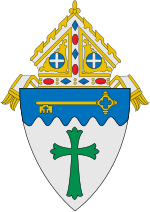John Mark Gannon
John Mark Gannon (June 12, 1877 – September 5, 1968) was an American clergyman of the Roman Catholic Church. He served as Bishop of Erie from 1920 to 1966, and was given the personal title of Archbishop in 1953.
The Most Reverend John Mark Gannon | |
|---|---|
| Archbishop of Erie | |
| See | Erie |
| Installed | December 16, 1920 |
| Term ended | December 9, 1966 |
| Predecessor | John Edmund Fitzmaurice |
| Successor | John Francis Whealon |
| Other posts | Auxiliary Bishop of Erie (1918-20) |
| Orders | |
| Ordination | December 21, 1901 |
| Consecration | February 6, 1918 |
| Personal details | |
| Born | June 12, 1877 Erie, Pennsylvania |
| Died | September 5, 1968 (aged 91) Erie, Pennsylvania |
| Denomination | Roman Catholic |
Ordination history of John Mark Gannon | |||||||||
|---|---|---|---|---|---|---|---|---|---|
| |||||||||
| |||||||||
He born in Erie, Pennsylvania, to Thomas Patrick and Julia (née Dunlavey) Gannon.[1] His uncle was pitcher Gussie Gannon. He attended St. Bonaventure's College near Olean, New York, where he earned a Bachelor of Arts degree in 1899.[2] He continued his studies at the Catholic University of America in Washington, D.C., earning a Bachelor of Sacred Theology (1900) and a Licentiate of Sacred Theology (1901).[2]
He was ordained to the priesthood on December 21, 1901.[3] In 1903, he earned Doctor of Divinity and Doctor of Canon Law degrees from the Apollinare University in Rome.[2] Returning to the Diocese of Erie, he held pastorates in McKean, Oil City, Cambridge Springs, and Meadville.[1] He became superintendent of diocesan schools in 1912.[1]
On November 13, 1917, Gannon was appointed Auxiliary Bishop of Erie and Titular Bishop of Nilopolis by Pope Benedict XV.[3] He was the first native of Erie to be so honored.[4] He received his episcopal consecration on February 6, 1918 from Bishop Michael John Hoban, with Bishops Philip R. McDevitt and John Joseph McCort serving as co-consecrators.[3] In addition to his episcopal duties, he continued to serve as superintendent of schools and was pastor of St. Andrew's Church.[1] Following the death of Bishop John Edmund Fitzmaurice, Gannon was named the fifth Bishop of Erie on August 26, 1920.[3] His installation took place on the following December 16 at St. Peter's Cathedral.[3]
Gannon became well known for his work in the field of education. He founded Cathedral Preparatory School in 1921, and encouraged the establishment of Villa Maria College and Mercyhurst College.[4] In 1933, he established Cathedral College, a two-year institution that was later renamed Gannon University in his honor.[4] Religious education programs under the auspices of the Confraternity of Christian Doctrine were organized in every part of the diocese, and he founded five regional high schools after age 80 alone.[2] He laid the cornerstone for St. Joseph's Home for Children in 1923, and founded Spencer Hospital in Meadville, St. Vincent's Hospital in Erie, Andrew Kaul Memorial Hospital in St. Marys, St. Mary's Home in Erie; Harborcreek Training School for Boys in Erie, Gannondale for Girls in Erie, and the Erie Day Nursery.[4] He also erected twenty-eight parishes, forty- nine churches, seven rectories, and twelve convents.[4]
In 1937, Gannon became head of the committee of American bishops that, in response to persecution of the Catholic Church in Mexico, founded Montezuma Seminary in New Mexico to train Mexicans for the ministry.[2] He was the episcopal moderator of the Catholic Press Association from 1937 to 1944, and was treasurer of the National Catholic Welfare Conference from 1944 to 1950.[1] He also served as chairman of the Commission for the Canonization of the Martyrs of the United States, and was the personal representative of the American hierarchy at the Eucharistic Congress in Brazil and at the fiftieth anniversary celebration of the pontifical coronation of the image of Our Lady of Guadalupe.[4] In 1938, he went to Spain to conduct his own investigation on reports of atrocities and persecution of the Church by the Loyalist Government.[2] On his return, he declared, "Communist cruelty and slaughter had consigned more than 11,000 of the Spanish priests and seminarians to martyrs' graves."[2] He founded Noticias Catolicas, a news service for Spanish- and Portuguese-speaking countries.[2]
Gannon was given the personal title of Archbishop by Pope Pius XII on November 25, 1953.[3] Between 1962 and 1965, he attended all four sessions of the Second Vatican Council. He resigned as Bishop of Erie on December 9, 1966; he was appointed Titular Archbishop of Tacarata by Pope Paul VI on the same date.[3] He died less than two years later, at age 91.
References
- Curtis, Georgina Pell (1961). The American Catholic Who's Who. XIV. Grosse Pointe, Michigan: Walter Romig.
- "Archbishop John Mark Gannon, Ex-Head of Erie Diocese, Dies". The New York Times. 1968-09-06.
- "Archbishop John Mark Gannon". Catholic-Hierarchy.org.
- "1918-1966: Golden Era". Roman Catholic Diocese of Erie. Archived from the original on 2007-05-18.
| Catholic Church titles | ||
|---|---|---|
| Vacant Title last held by Juan Bautista Gorordo |
— TITULAR — Bishop of Nilopolis 1917 – 1920 |
Vacant Title next held by Francisco Javier Baztán y Urniza |
| Preceded by John Edmund Fitzmaurice |
Bishop of Erie 1920 – 1966 |
Succeeded by John Francis Whealon |
